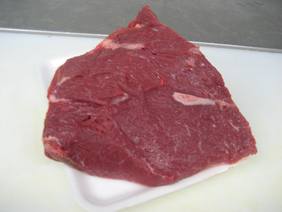Rump Roast
Rump Roast
Flavor: 3 Out Of 5
Alternative Names: Diamond Cut Roast, Manhattan Roast, Round Roast, Bottom Round Oven Roast, Bottom Round Pot Roast
The rump comes from a portion of the beef that lies partially in the round and partially in the top sirloin. This triangular shaped roast makes a juicy beefy roast at a reasonable price.
A rump that contains a moderate amount of fat and marbling, will be moist and tender enough to oven dry roast.
However we also like to cook a rump using the pot roast method, follow the instructions for cooking blade roast, this method gives it great flavor and the rump will not be as dry.
To bring out additional flavor and produce a more buttery texture you can dry age the roast for a few days. Age the beef in the refrigerator by leaving it uncovered on a wire rack over a pan to catch the drippings for at least a day or as long as 3-4 days.
When you are ready to cook the roast, trim off any dried pieces after the aging. It is common for a roast to lose 5%-15% of its weight during the aging.
Cooking Instructions
Rump Roast Recipe
A low temperature of 250 degrees will cook the meat evenly through from the center to the outer edge without any drying out, leaving the meat tender and juicy.
You might be concerned about the possibility of bacteria and it has been shown that this way of cooking is actually safe but to have piece of mind there is a way to solve this and at the same time give the roast a nice brown surface.
Bacteria grows from the outside and a way to get rid of bacteria is to sear the roast first. Searing the roast will seal in the juices leaving your rump roast recipes looking very appealing when being served.
1. An hour before cooking, remove the roast from the refrigerator to bring to room temperature.
2. Preheat the oven to 250 degrees and set the rack to the lower middle position.
Take a heavy bottomed roasting pan or cast iron skillet, set on stove top and heat the pan or skillet to medium-high. Once the pan is hot sear the roast on all sides 1½-2 minutes per side for about 6-8 minutes total time.
3. Carefully remove the roast, set a wire rack in center of the roasting pan and place roast fat side up on the rack.
Season with salt and pepper and generously sprinkle your favorite seasonings, such as onion or garlic powder etc. Cloves of garlic may be used cut in half lengthwise and with a small knife cut small slits into the top of the roast and insert the garlic clove halves into the roast.
4. Transfer the pot to the oven and cook, uncovered until an instant-read thermometer inserted into the thickest part of the roast registers 130-140 degrees, about 1-2 hours depending on size and shape. I recommend checking the temperature 45 minutes to 1 hour after entering the oven.
5. Remove the rump roast from oven and tent with foil. Let it rest at least 15- 20 minutes to allow the juices to redistribute themselves evenly throughout the roast. Cut across the grain into thin slices.
 |
Below is a cooking chart for the oven rump roast. Remember you should always use an instant-read thermometer to check the doneness of a roast. The internal temperature will rise about 5-10 degrees during resting time, remove the roast 5-10 degrees before desired doneness. A thermometer will eliminate the guess work when learning how to make roast beef.
| Doneness | Description | Meat Thermometer Reading |
| Rare | Red with cold, soft center | 125-130 degrees |
| Medium-Rare | Red with warm, somewhat firm center | 135-140 degrees |
| Medium | Pink and firm throughout | 140-150 degrees |
| Medium-well | Pink line in center, quite firm | 150-155 degrees |
| Well-done | Gray-brown throughout and completely firm | 160-165 degrees |
Return To Home Page
Return To Beef Roasts
Return To Top - Rump Roast
US To Metric System Chart
Oven Temperatures
Fahrenheit (°F) Celsius (°C)
125° 52°
150° 66°
175° 80°
200° 93°
225° 107°
250° 121°
275° 135°
300° 149°
325° 163°
350° 177°
375° 190°
400° 205°
425° 218°
450° 232°
475° 246°
500° 260°




